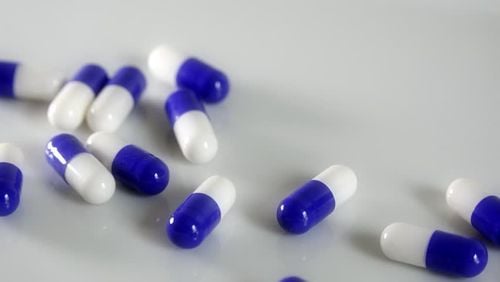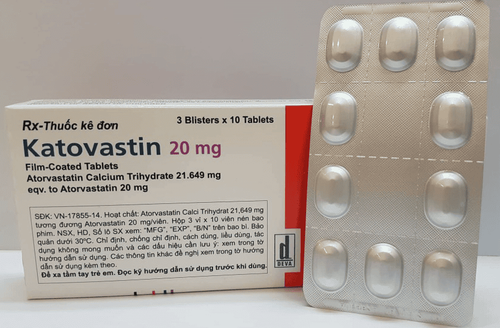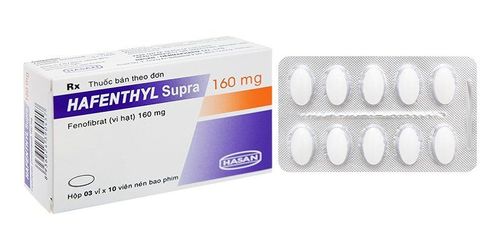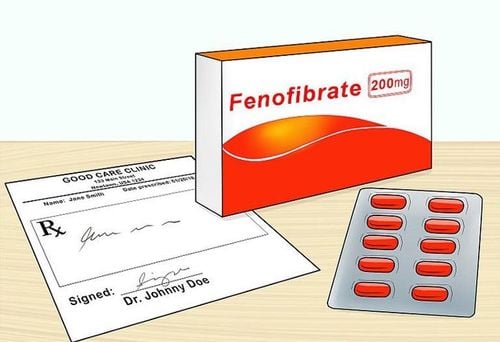This is an automatically translated article.
Fenofibrate is an effective cholesterol and triglyceride lowering drug. This active ingredient has many different trade names, including the drug Fenbrat 160m.
1. What is Fenbrat?
Fenbrat 160m has the active ingredient Fenofibrate (in the form of micronized Fenofibrate) with a content of 160mg. Fenbrat 160m is manufactured by Mebiphar Pharmaceutical and Biomedical Joint Stock Company (Vietnam). The active ingredient Fenofibrate in Fenbrat 160m can help reduce blood cholesterol by about 20-25% and reduce blood triglycerides by 40-50%. The cholesterol-lowering effect of Fenbrat 160m is due to the fact that the drug has reduced low-density atherosclerotic components (including VLDL and LDL-C). Fenbrat 160m improves plasma cholesterol distribution by reducing the total cholesterol/HDL-C ratio, which is often elevated in atherosclerotic hyperlipidemia. An association between hypercholesterolemia and atherosclerosis has been demonstrated, similar to the association between atherosclerosis and coronary artery disease. Low HDL-C levels are associated with an increased risk of coronary heart disease. Fenofibrate significantly increased LDL-C levels by 10-30% for patients reaching the treatment goal of 40 mg/dl regardless of baseline. Elevated triglyceride levels are associated with increased vascular risk, but this association is independent of the associations above. In addition, triglycerides have been implicated in the atherosclerotic process as well as thrombosis.
In case of extravascular hypercholesterolemia, long-term treatment with Fenbrat 160m can be significantly improved, even completely cured.
Another effect of Fenofibrate is to increase Apoprotein A1 and decrease Apoprotein B, improving the ratio of apo A1/apo B helps to improve the atherogenic factor. With the ability to activate the PPAR type A (peroxisome proliferator activated receptor of type a) receptor, fenofibrate increases lipolysis and elimination of triglyceride-rich particles by activating lipoprotein lipase and decreasing apoprotein C III production.
2. Indications and contraindications of Fenbrat 160m
Fenbrat 160m is indicated in the following cases:
Hypercholesterolemia type IIa, isolated endogenous hypertriglyceridemia (type IV) or combined hyperlipidemia type IIb and III after dieting. fit without being effective; Fenbrat 160m is indicated in secondary hyperlipoproteinemia, persistent despite treatment of the cause (eg dyslipidemia in diabetes); It should be noted: The diet that was applied before using Fenbrat 160m must still be maintained.
Contraindicated to use Fenbrat 160m in the following cases:
Patients with hypersensitivity to Fenofibrate or any ingredient in Fenbrat 160; Patients with severe renal dysfunction; Patients with liver dysfunction or gallbladder disease; Do not use Fenbrat 160m for children under 10 years old, pregnant and lactating women; Do not use Fenbrat 160m in patients who have allergic reactions to light when using Fibrates or Ketoprofen groups.
3. Dosage of Fenofibrate
Patients using Fenbrat 160m should be combined with a suitable diet. The best time to drink Fenbrat 160m is at the main meal. Dosage and time of taking Fenbrat 160m is decided by the treating doctor.
The usual recommended dose is as follows:
Adults: 100mg tablets: 3 tablets/day; 300mg, 200mg and 160mg tablets (Fenbrat 160m): 1 tablet/day; Children over 10 years old: Use a maximum dose of 5mg/kg/day. It should be noted: The above drug dosage is for reference only, the patient needs to take the drug according to the prescription of the doctor based on the patient's condition and ability to respond to the drug.
4. Side effects of Fenbrat 160m
As with other fibrates, cases of muscle damage (including diffuse myalgia, increased sensitivity to pain or weakness) as well as rare (sometimes severe) cases of rhabdomyolysis have been reported. reported with the use of Fenbrat 160m. However, this side effect is usually reversible when the patient stops taking the drug.
Some other adverse effects of Fenbrat 160m, which are less common and milder, have also been reported as follows:
Dyspepsia gastrointestinal disorders; Increased liver transaminases ; Skin reactions such as rash, itching, urticaria or photosensitivity. In some cases, even after many months of taking Fenbrat 160m, no side effects occurred. Skin condition that is hypersensitive to manifestations such as rashes, blisters or eczema in areas exposed to sunlight or artificial UV rays.
Currently, there are no controlled studies documenting the adverse effects of long-term use of Fenbrat 160m, most notably the risk of gallstones.
5. Pay attention when using Fenbrat 160m
During the use of Fenbrat 160m, patients should note:
Patients taking Fenbrat 160m need to be tested for liver function and kidney function before treatment. If, after 3-6 months of treatment with Fenbrat 160m, there is no reduction in blood lipid levels, additional or complete replacement therapy with another drug should be considered. The increase in liver transaminase levels is only temporary. Patients should be periodically tested for liver transaminases every 3 months during the first 12 months of Fenbrat 160m and treatment should be discontinued if AST and ALT elevations are above 3 times the upper limit of normal. Patients who need to combine Fenbrat 160m with oral anticoagulants should have increased prothrombin blood levels monitoring and anticoagulant dose adjusted accordingly during treatment and for at least 8 days after discontinuation of Fenbrat. 160m . Bile complications of Fenbrat 160 are more likely to occur in people with a history of cholestatic cirrhosis or gallstones. At the same time, during the use of Fenbrat 160m, the patient must regularly have a blood count checked. Fenbrat 160m has the active ingredient Fenofibrate. This is an effective drug to help lower cholesterol and blood triglycerides. In order to increase the effectiveness of treatment, avoid side effects and unwanted interactions, patients need to take the drug exactly as directed by the doctor or pharmacist.
Follow Vinmec International General Hospital website to get more health, nutrition and beauty information to protect the health of yourself and your loved ones in your family.
Please dial HOTLINE for more information or register for an appointment HERE. Download MyVinmec app to make appointments faster and to manage your bookings easily.













